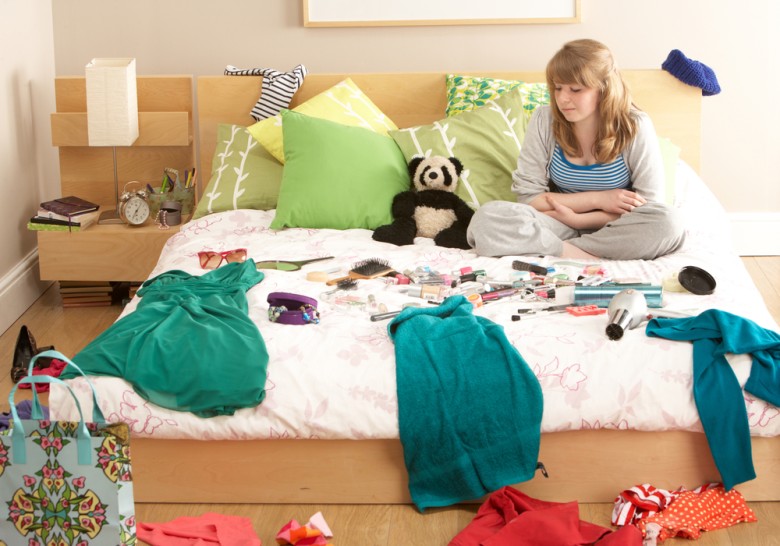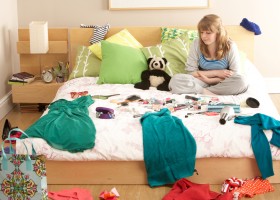Your Teen's Room

One of the more common sources of frustration for parents of teens is figuring out an effective way to get them to keep their rooms clean. Sometimes this revolves around simply getting the beds made, putting laundry in the hamper, and getting the large amounts of debris cluttering the room picked up and put away. It's not uncommon for a fifteen year old boy's room to smell more like the inside of locker room, or for a girl's room to be so littered with clothes that you can't find the floor.
Other times the struggle revolves around disagreements on what posters should be up on the walls, what colors the room can be painted, or even who's allowed in the room and under what restrictions. In general, the struggle between parents and adolescents over the teen's room seems to take several distinct shapes. These are (1) the issue of keeping the room clean; (2) how the room can be decorated; and (3) issues around privacy. In order for you to come up with rules and strategies that are reasonable for both you and your teen, it is helpful to first gain an understanding of the significance of this hallowed space for adolescents. The question is "How does the teen's room contribute to the basic developmental tasks of adolescence?"
Functions of "The Room"
Most of you who grew up in the heyday of the Beachboys will remember a song called In My Room. This song captured well the feeling that an adolescent has about the sort of private retreat quality that they ascribe to their rooms. It is a place where they can be alone with themselves and ponder those deep and distressing emotional ups and downs that they confront in the world, especially those involving their relationships with parents and peers. It is a place were one can have privacy with feelings and thoughts, as well as a mental space for resolving conflicts, making plans, or just allowing one's mind to drift and daydream about future possibilities. It is the oasis in the desert as well as the hidden attic where solitude is found.
A teen's room has another very special significance that is directly related to the primary developmental task of adolescence, which is building a personal identity. As the child moves into adolescence, the room becomes more and more like an extension of the self in which various expressions of the self appear. It is like a lab where the teen can visually and actively experiment with various identities as well as locate oneself within one's particular culture. You might see a whole wall covered with pictures of models, popular musicians, sports figures, or other icons of the teen world to which your teen may either aspire to be like, or that represent something that is considered desirable. The adolescent boy that is playing basketball may have posters of Kobe Bryant or Michael Jordan plastered all over the walls. Or a teen girl may choose supermodels or movie stars. On a more negative note, however, a teen who is becoming involved in regular marijuana use may have pictures of drug abusing rock stars, or paraphernalia that is associated with drug use. The point is, the choice of decoration, style, and items for display are extensions in some way or another of the identity your teen is formulating, or at least considering, and the culture in which he is negotiating his identity.
One other important function that the teen's room serves is that it supplies the first individual space that the teen can call his own and that has boundaries which separate it from the rest of the house and family. It is a private space in this regard that is both the responsibility of the occupant, and the place where special interactions with others take place. A conversation that occurs in this room is going to have a somewhat different quality than a conversation that occurs in the living room, kitchen, or other part of the house. This is the private space where friends visit and intimate conversations can take place. This privacy, however, comes with the price of responsibility. The upkeep of the space also belongs to the occupant. Moreover, the privacy and ownership of the space implies a mutual trust between the occupant and the landlord (parents). What goes on in the room must meet the requirements of the landlord, and the upkeep and cleanliness must also meet their approval. Let's move on now to our discussion of the three areas of conflict regarding the teen's room that were outlined in the introduction.
Issues of Cleanliness
There are two parts to this discussion. The first has to do with how the parents define cleanliness, what the expectations are around cleanliness and neatness, and how this translates into daily cleaning, weekly cleaning, etc. The second part of the discussion is focused more on how to gain your teen's cooperation in meeting the expectations you have outlined. Let's take a look.
Expectations
Generally, parents seem to fall into one of several categories. One group of parents likes their kids' bedrooms to be kept clean and neat on a daily basis. They want the beds made everyday, clothes put away in the hamper, and all extraneous items kept in locations that have been designated for them. This means books on the bookshelf, clothes hung in the closet or folded in the drawers, etc. A second group of parents allow a certain amount of messiness and disorganization to occur over a week's span, and then require a thorough cleaning and picking up of the room once a week (generally on the weekend). Often the teen's room is cleaned in conjunction with an overall weekly house cleaning. A third set of parents are somewhat oblivious to the way the room is kept. Their attitude is that it is their teen's private space and if it gets messy enough so that they can't find things, they'll clean it without prompting.
We suggest that you include your teens in an initial planning discussion so that they participate in defining of the expectations. This doesn't mean that you don't have the final decision, it just means that teens who are involved in the planning process are much more likely to live up to their part of the bargain. It is important that the expectations are spelled out in great detail. If you decide on the weekly cleaning, then you will need to be very explicit on how messy the room can be during the weekly interim. Is food allowed in? Can dishes be left around? Can dirty clothes be piled on the floor? Or maybe you would prefer no food is taken in the room and dirty clothes must be kept in the hamper, but general messiness can occur such as leaving items in disarray (school books, video games, etc.). When cleaning is to be done, again you must be very specific. Does it include vacuuming, and does this mean vacuuming only visible space or under furniture also? Does the room have to be dusted? The closets cleaned out? You get the idea. Together with your teen, define the expectations and rules. Be sure that everyone is on the same page and in agreement. This prior agreement is very important as it supplies the basis for reinforcing the agreement down the road.
Our general advice is to steer away from extremes. Not allowing any mess can inhibit some of the more exploratory needs of the adolescent who is developing an identity. At the same time, allowing total chaos and irresponsibility is never a good practice, and doesn't teach the necessary lessons for living with others or organizing one's life. It makes sense to require at least a weekly cleaning. This teaches a certain respect for one's space, as well as skills in organization, planning, and of course housekeeping. It is also important that respect for personal property is instilled along with a respect for organization that allows one to function successfully on a daily basis. As much as possible, the rules for the teen's room should mirror those of the overall household, although some relaxation may be appropriate at this age. Messy teens very often turn into good adult housekeepers, particularly if this is the atmosphere in which they have grown up.
Reinforcing Expectations
Now that you have an agreement in place regarding the expectations and rules, you need to define logical consequences to be enforced if the agreement is broken. Let's say you and your teen have agreed that they don't have to keep their room in perfect order during the week, but they must put dirty clothes in the hamper on a daily basis and dirty dishes are not allowed to be left in the room under any circumstances. Further, once a week the bed needs to be changed, all items must be put away, the room vacuumed (visible floor only), and everything dusted. You need to spell out a time frame for the cleaning. You might say it must be completed by 3 PM every Saturday. That allows the choice of doing it Friday afternoon or evening, or on Saturday morning. If not done by the appointed time, social plans made for Saturday will be cancelled. Then, give your teen a chance to get it done on Sunday in order to continue with social plans on Sunday, but again, if it is not done, social plans for Sunday will be cancelled. Another logical consequence might be that clothes not placed in the hamper would not be washed and therefore not available when your teen needs them to wear. You might give the total responsibility for washing and drying clothes to your teen, which not only teaches him to be competent in taking care of himself, but gives him an opportunity to learn from his mistakes, i.e., clothes are simply not available when desired. Whenever possible, make the consequence a natural or logical consequence. Further, when you need to enforce it, do it without the "I told you so's." In fact, you can empathize with the painfulness of having to learn and bear consequences of one's own making while yet maintaining the limits you have set. Above all, don't participate in arguments. If the expectations are agreed on ahead of time, along with consequences, then there really is no room for argument. Simply carry them out.
Decorating the Room
In general, teens love to decorate their rooms. Decorating usually involves the arrangement and selection of furniture, color of the walls, wall coverings such as posters and pictures, and display of favorite items. Some teens are very conservative and prefer a more standard decorating scheme that is very functional and ties in with the rest of the house. At the other extreme is the teen who wants little to no furniture, or very different looking furniture (like sleeping on the floor on an air mattress, blow up furniture, waterbeds, etc.) They may want the walls to have more than the standard posters. I've known teens who paint murals and scenes on their walls that flow into the ceiling area, or they hang numbers of items from the ceiling, have different types of lighting, and so forth. The extent of deviation from regular house decoration schemes is a point of discussion for you and your teen. Our general advice is to allow a good deal of flexibility. Two rules of thumb can be used to help you decide how far from the norm you will allow your teen to stray in choosing decorations. First, the desired decorations should not fall far from your general family values and/or norms for behavior. In other words, putting up posters of related to drug use, symbols that advocate violence toward others, or other provocative expressions of antisocial behavior are most likely going to go against the values you have tried to instill. If your teen seems particularly interested in these types of decorations, discuss what it is that she finds interesting. It is important to know what your teen is thinking, feeling, and how she is trying to locate herself within her peer group and culture. Her choice of decorations often can be very telling and offers an opportunity for frank discussion and problem solving. Second rule of thumb is to set a budget for decorating that includes your part and her part. Assist your teen with this task and participate in helping her come up with ideas that are economical.
Issues of Privacy
Privacy is a strong need for teens. They need room to try out the various aspects of their personalities, select traits that help build an identity, and test ways to participate in the culture. One of the ways teens can experiment with privacy in a fairly safe manner is within the space of their own rooms. We suggest that you allow your teen the experience of being alone with himself while being able to maintain boundaries against intrusion by others, including you. The general suggested rules are that teens are allowed to close their doors while alone, or with friends or siblings. You might make one exception to this rule and that is in regard to members of the opposite sex. That is up to you and may depend on your level of trust and frank discussion with your teen regarding sexuality. Secondly, it is important that anyone who wants to enter the teen's room knock first and wait to be invited in before entering. This is a very important one. Many parents knock, but they enter while in the process of knocking which is close to entering with no warning. None of us like that sort of intrusion and we generally react with anger. Give your teens the same courtesy you expect from them. As budding adults, teens need both emotional and physical privacy. If this rule is observed at all times, then there will be no need for locking doors. Locking doors is not suggested as it is important that access be maintained in case of an emergency.
Now, what do you do if you find that your teen is involved in behaviors in his room you do not approve of such as drinking. This is an issue that needs to be discussed frankly and you may remove privacy privileges temporarily until trust has been reestablished. Privacy is important, but it does imply responsibility. Teens don't tell their parents everything, nor should they. At the same time, a general sense of trust along with limits that protect teens from danger must be facilitated. Your best bet is to spend a lot of time getting to know your teens, discussing their ideas as well as problems, and establishing a strong bond that is based on caring and understanding. This will promote an atmosphere where both closeness and privacy can be maintained at the same time, very much like the teen's room that is nestled in the warmth of the family home.









